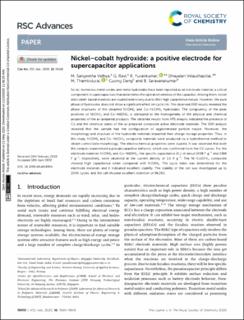| dc.contributor.author | Vidhya, S | |
| dc.contributor.author | Ravi, G | |
| dc.contributor.author | Yuvakkumar, R | |
| dc.contributor.author | Velauthapillai, Dhayalan | |
| dc.contributor.author | Thambidurai, M | |
| dc.contributor.author | Dang, Quong | |
| dc.contributor.author | Saravanakumar, B | |
| dc.date.accessioned | 2020-12-10T13:09:21Z | |
| dc.date.available | 2020-12-10T13:09:21Z | |
| dc.date.created | 2020-07-22T10:50:13Z | |
| dc.date.issued | 2020 | |
| dc.identifier.citation | Vidhya, M. S., Ravi, G., Yuvakkumar, R., Velauthapillai, D., Thambidurai, M., Dang, C., & Saravanakumar, B. (2020). Nickel–cobalt hydroxide: A positive electrode for supercapacitor applications. RSC Advances, 10(33), 19410–19418. | en_US |
| dc.identifier.issn | 2046-2069 | |
| dc.identifier.uri | https://hdl.handle.net/11250/2716947 | |
| dc.description.abstract | So far, numerous metal oxides and metal hydroxides have been reported as an electrode material, a critical component in supercapacitors that determines the operation window of the capacitor. Among them, nickel and cobalt-based materials are studied extensively due to their high capacitance nature. However, the pure phase of hydroxides does not show a significant effect on cycle life. The observed XRD results revealed the phase structures of the obtained Ni(OH)2 and Co–Ni(OH)2 hydroxides. The congruency of the peak positions of Ni(OH)2 and Co–Ni(OH)2 is attributed to the homogeneity of the physical and chemical properties of the as-prepared products. The obtained results from XPS analysis indicated the presence of Co and the chemical states of the as-prepared composite active electrode materials. The SEM analysis revealed that the sample had the configuration of agglomerated particle nature. Moreover, the morphology and structure of the hydroxide materials impacted their charge storage properties. Thus, in this study, Ni(OH)2 and Co–Ni(OH)2 composite materials were produced via a hydrothermal method to obtain controllable morphology. The electrochemical properties were studied. It was observed that both the samples experienced a pseudocapacitive behavior, which was confirmed from the CV curves. For the electrode materials Ni(OH)2 and Co–Ni(OH)2, the specific capacitance (Cs) of about 1038 F g−1 and 1366 F g−1, respectively, were observed at the current density of 1.5 A g−1. The Ni–Co(OH)2 composite showed high capacitance when compared with Ni(OH)2. The cycle index was determined for the electrode materials and it indicated excellent stability. The stability of the cell was investigated up to 2000 cycles, and the cell showed excellent retention of 96.26%. | en_US |
| dc.language.iso | eng | en_US |
| dc.publisher | Royal Society of Chemistry | en_US |
| dc.rights | Navngivelse-Ikkekommersiell 4.0 Internasjonal | * |
| dc.rights.uri | http://creativecommons.org/licenses/by-nc/4.0/deed.no | * |
| dc.title | Nickel-cobalt hydroxide: a positive electrode for supercapacitor applications | en_US |
| dc.type | Peer reviewed | en_US |
| dc.type | Journal article | en_US |
| dc.description.version | publishedVersion | en_US |
| dc.source.pagenumber | 19410-19418 | en_US |
| dc.source.volume | 10 | en_US |
| dc.source.journal | RSC Advances | en_US |
| dc.source.issue | 33 | en_US |
| dc.identifier.doi | 10.1039/D0RA01890B | |
| dc.identifier.cristin | 1820157 | |
| cristin.ispublished | true | |
| cristin.fulltext | original | |
| cristin.qualitycode | 1 | |

